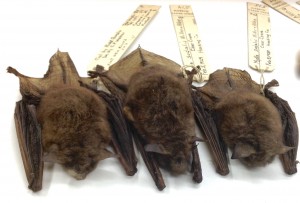by Raymond Gonzo
Part of the Tetrapod collection holds preserved reptiles, most of which represent native Ohio species along with several species from other parts of North America. To find a Species of the Month, I ventured down the aisles of shelves with jars of snakes, lizards, turtles, and tortoises. When I saw this Timber Rattlesnake, one of our collection’s most impressive reptilian specimens, I made my choice. I chose an animal that is feared, and misunderstood, by many.
Attaining an average length of about 3-4 feet, the Timber Rattlesnake (Crotalus horridus – a frightening name for an animal that rather avoids than seeks conflict) is a fairly large snake. Like most snakes, Timber Rattlesnakes are feared by a lot of people who don’t understand them well enough. It’s important to remember that snakes such as the Timber Rattlesnake don’t seek out conflict with humans, but rather try to avoid it. A part of the fear people have for snakes comes from common misconceptions, which these facts below will hopefully clear up.
Their range stretches throughout most of the temperate forests in the Eastern United States and Canada, however they can no longer be found in Maine and Ontario. Here in Ohio, they can really only be found at the southern end of the state. Timber Rattlesnakes will mate during the spring and fall with the females giving birth to anywhere from 4-14 young during the late summer. What’s interesting about rattlesnakes (Timbers included) is that they give birth to live young, which is very unusual for a reptile. Many reptiles, just like birds, usually lay eggs from which their young hatch after some incubation time. When the snakes feel threatened, Timber Rattlesnakes will rattle their iconic tails as a warning to potential predators that get too close. These snakes eat a wide assortment of small mammals and can sense their prey using special heat sensory organs that are located on their heads. These sensory organs are known as loreal pits and are a characteristic common to all members of the pit viper family, which includes rattlesnakes.
When Timber Rattlesnakes deliver a bite, deadly venom will be injected through the snake’s hollow fangs and into the victim. A common misconception is that snakes are poisonous; when in actuality they are venomous. Venomous organisms directly inject venom into the victim whereas poisonous organisms have a poisonous substance covering their body making them dangerous only when eaten or touched. Learn more general facts about Timber Rattlesnakes from an Ohio Certified Volunteer Naturalist.
Quite a bit of research has been done on these snakes, a few years ago Rokyta et al (2013) reported that components of their venom seem to have changed. Some species of snakes (Timber Rattlesnake included) have undergone a dramatic shift in the lethality, and composition of the venoms they produce. Traditionally, Timer Rattlesnakes produced a hemorrhagic type of venom, which causes the snake’s victims to bleed to death from the inside out (visit the Snakes and Spiders web site for a full description of how snake venom works). However, this study shows that, at the southern end of their range, Timber Rattlesnakes are beginning to develop a bite consisting of neurotoxin venom. Neurotoxins attack the victim’s central nervous system resulting in cardiac arrest and trouble breathing thus making it much deadlier than hemorrhagic toxins. Similar research on the evolution of snake venoms is being done at the molecular level by researchers in the Gibbs lab here at OSU.
Timber Rattlesnakes are amazing animals that encompass both beauty and lethality. Their status as a top predator has even landed them a place in history as the species of snake that appears on the “Don’t Tread on Me” flag. While these are highly venomous creatures, it’s important to remember that they just want to be left alone and do their best to avoid conflict with humans. Should a Timber Rattle snake bite you or someone you are with then please follow the procedures outlined by the Wild Backpacker to ensure a safe and speedy recovery from any venom related injuries. If you ever encounter a Timber Rattlesnake NEVER try to approach or pick it up, instead leave it alone and in turn it will leave you alone. Timber Rattlesnakes remind us that sometimes it best to admire natural beauty from a distance.
References
“Snake Bite First Aid and Treatment.” Wild Backpacker – Survival articles
http://www.wildbackpacker.com/wilderness-survival/articles/treating-a-snake-bite
Rokyta D.R., Wray K.P., and Margres M.J. 2013 The Genesis of an Exceptionally Lethal Venom in the Timber Rattlesnake (Crotalus Horridus) Revealed through Comparative Venom-gland Transcriptomics. BMC Genomics 14, 394. BioMed Central. http://www.biomedcentral.com/1471-2164/14/394/
“Understanding Snake Venom and How It Works.” Snakes and Spiders, 3 Nov 2009.
http://www.snakesandspiders.com/understanding-snake-venom-works/



